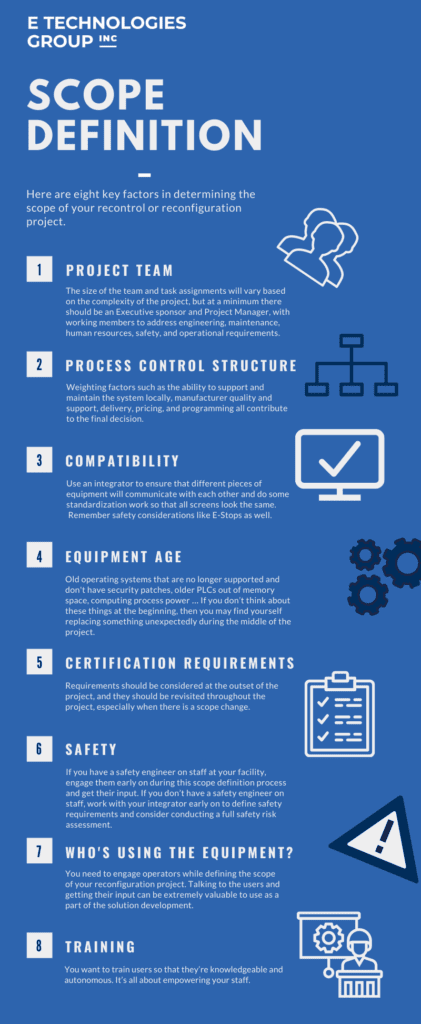
It’s common for manufacturers to need to update equipment – corporate standards change, production goals increase, and demand can fluctuate, sometimes at lightning speed. Purchasing new equipment isn’t always feasible with budget constraints, requiring engineers to get creative with a solution that meets the new goals or standards while not breaking the bank. Often, changes can be made to what the facility is already working with. While this is often less expensive than purchasing new equipment to accommodate whatever goals a facility may have, it’s not without risks.
We’ve done hundreds of projects like these for manufacturers in various industries, and over the years we’ve learned what it takes to make a reconfiguration or re-control project successful. It starts with a clear and confirmed understanding of the goals and scope of the project. Here are our top eight factors in properly determining the scope of your machine rebuild, reconfiguration or re-control project:

1. Project Team
In the most effective recontrol/reconfigure projects, the team involved includes more than just the system engineers. The integrator should work closely with representatives from the client, including an executive, a manager, and any employees who will be directly affected by the project. A collaborative approach to a project only improves its potential for success.
2. Process Control Structure
Look at all aspects of client operations: system support and maintenance, product quality, packaging, delivery, pricing. Balancing needs, timeline and cost is key before moving forward in a recontrol project.
3. Compatibility
Control system integrators are vital to ensuring that standalone pieces of equipment can, in fact, be integrated. Different pieces of automated equipment need to be able to communicate with each other, as well as being coherently translated at the human-machine control interface.
4. Equipment Age
The condition and age of equipment determines its viability – is the processor out of date? Is the OP still supported? Is the processing power sufficient for the facilities’ needs? Computer memory is another all-important factor. Assessing equipment at the outset of a project avoids unexpected and unnecessary complications mid-project when you find out the equipment just isn’t going to cut it.
5. Certification Requirements
All industrial sectors – from pharmaceuticals to food and beverage to chemicals – have certain certifications and regulations they must adhere to. Determine what these are, identify benchmarks, locate any obstacles, and make sure to re-evaluate compliance throughout the project.
6. Safety
Most industrial facilities, necessarily, retain their own safety engineer(s), and these are the people to talk to about safety system requirements. As well, the system integrator will have a safety specialist on-hand. These positions should work closely to determine key concerns and analyze risk as the project scope is defined.
7. Equipment Users
Collaboration is such a key part of proficient control system integration. Identify who will use the equipment. Ask their needs and wants – how do they think their automated processes could benefit from a recontrol project? The better tailored a control system solution is to the client, the more value the client will reap from the finished project.
8. Training
What’s the good of a plant-wide retrofit if users aren’t well-educated on how to use it to its fullest potential? Understanding the needs and abilities of users from the outset of the process will help inform the automation engineers on the best design for the reconfiguration.
A revamp of your building’s automation and an upgrade to its control system has the potential to raise your facility to the level it needs to be without requiring a plant-wide retrofit, which causes downtime and interrupts production. When facing end-of-life obsolescence with your automation equipment, consult a control system integrator before you clean house; the right engineers, advanced software, and control system design may save you time and money while still bringing your facility up to the operational degree you need it to be.